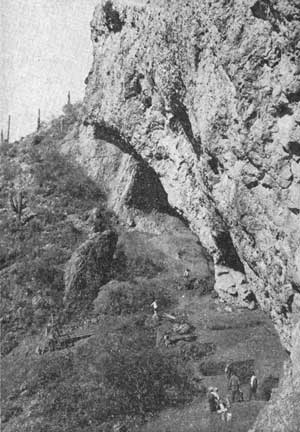
Mogollon culture is an archaeological culture of Native American peoples from Southern New Mexico and Arizona, Northern Sonora and Chihuahua, and Western Texas. The northern part of this region is Oasisamerica, while the southern span of the Mogollon culture is known as Aridoamerica.

The Hohokam Pima National Monument is an ancient Hohokam village within the Gila River Indian Community, near present-day Sacaton, Arizona. The monument features the archaeological site Snaketown 30 miles (48 km) southeast of Phoenix, Arizona, designated a National Historic Landmark in 1964. The area was further protected by declaring it a national monument in 1972, and was listed on the National Register of Historic Places in 1974.

Emil Walter "Doc" Haury was an influential archaeologist who specialized in the archaeology of the American Southwest. He is most famous for his work at Snaketown, a Hohokam site in Arizona.
The Gila Pueblo Archaeological Foundation was a research organization which conducted archaeological research in the American Southwest and surrounding areas. It was founded in 1928 in Globe, Arizona, by Harold S. Gladwin and Winifred (McCurdy) Gladwin. It ceased operations in 1950.

Calosoma sycophanta, the forest caterpillar hunter, is a species of ground beetle belonging to the family Carabidae.

The Point of Pines Sites are a set of archaeological sites on the San Carlos Apache Indian Reservation in the U.S. state of Arizona. Located around the settlement of Point of Pines, they are significant for associations with Ancestral Pueblo, Mogollon and Hohokam cultures. The sites were chosen as a field school location by Dr. Emil Haury because of the unusual presence of all three major prehistoric cultures of Arizona. The field school ran from 1946 to 1960, collecting large amounts of evidence from numerous sites. The site were collectively declared a National Historic Landmark in 1964.

Ventana Cave is an archaeological site in southern Arizona. It is located on the Tohono O'odham Indian Reservation. The cave was excavated under the direction of Emil Haury by teams led by Julian Hayden in 1942, and in 1941 by a team led by Wilfrid C Bailey, one of Emil Haury's graduate students. The deepest artifacts from Ventana Cave were recovered from a layer of volcanic debris that also contained Pleistocene horse, Burden's pronghorn, tapir, sloth, and other extinct and modern species. A projectile point from the volcanic debris layer was compared to the Folsom Tradition and later to the Clovis culture, but the assemblage was peculiar enough to warrant a separate name – the Ventana Complex. Radiocarbon dates from the volcanic debris layer indicated an age of about 11,300 BP.

The Arizona State Museum (ASM), founded in 1893, was originally a repository for the collection and protection of archaeological resources. Today, however, ASM stores artifacts, exhibits them and provides education and research opportunities. It was formed by authority of the Arizona Territorial Legislature. The museum is operated by the University of Arizona, and is located on the university campus in Tucson.

Calosoma is a genus of large ground beetles that occur primarily throughout the Northern Hemisphere, and are referred to as caterpillar hunters or caterpillar searchers. Many of the 167 species are largely or entirely black, but some have bright metallic coloration. They produce a foul-smelling spray from glands near the tip of the abdomen. They are recognizable due to their large thorax, which is almost the size of their abdomen and much wider than their head.

The Naco Mammoth Kill Site is an archaeological site in southeast Arizona, 1 mile northwest of Naco in Cochise County. The site was reported to the Arizona State Museum in September 1951 by Marc Navarrete, a local resident, after his father found two Clovis points in Greenbush Draw, while digging out the fossil bones of a mammoth. Emil Haury excavated the Naco mammoth site in April 1952. In only five days, Haury recovered the remains of a Columbian Mammoth in association with 8 Clovis points. The excavator believed the assemblage to date from about 10,000 Before Present. An additional point was found in the arroyo upstream. The Naco site was the first Clovis mammoth kill association to be identified. An additional, unpublished, second excavation occurred in 1953 which doubled the area of the original work and found bones from a 2nd mammoth. In 2020, small charcoal fragments were found adhered to a mammoth bone from the site. AMS radiocarbon dating produced a mean date of 10,985 ± 56 Before Present.

Calosoma inquisitor is a species of ground beetle. The species is found in northern Africa, Europe and East to Asia Minor, Iran and the Caucasus, with isolated populations in eastern Siberia and Japan.

Calosoma investigator is a species of ground beetle belonging to the genus Calosoma and the subgenus Charmosta. The species is diffused in North-Eastern Europe and Siberia.
Gustav Adolph Haury Jr. was an American football coach. He was the head football coach at the Bethel College in North Newton, Kansas, serving for six seasons, from 1922 to 1927, and compiling a record of 5–30.

Carabinae is a subfamily of ground beetles in the family Carabidae. There are about 10 genera and more than 1,400 described species in Carabinae.
Calosoma abyssinicum is a species of ground beetle in the subfamily of Carabinae. It was described by Gestro in 1880.
Carenum viridissimum is a species of ground beetle in the subfamily Scaritinae, found in Australia. It was described by William John Macleay in 1888.
Clara Lee Tanner was an American anthropologist, editor and art historian. She is known for studies of the arts and crafts of American Indians of the Southwest.

The common green racer is a species of venomous snake of the family Colubridae.
Yannick Haury is a French politician representing the Democratic Movement. He was elected to the French National Assembly on 18 June 2017, representing the 9th constituency of the department of Loire-Atlantique.











